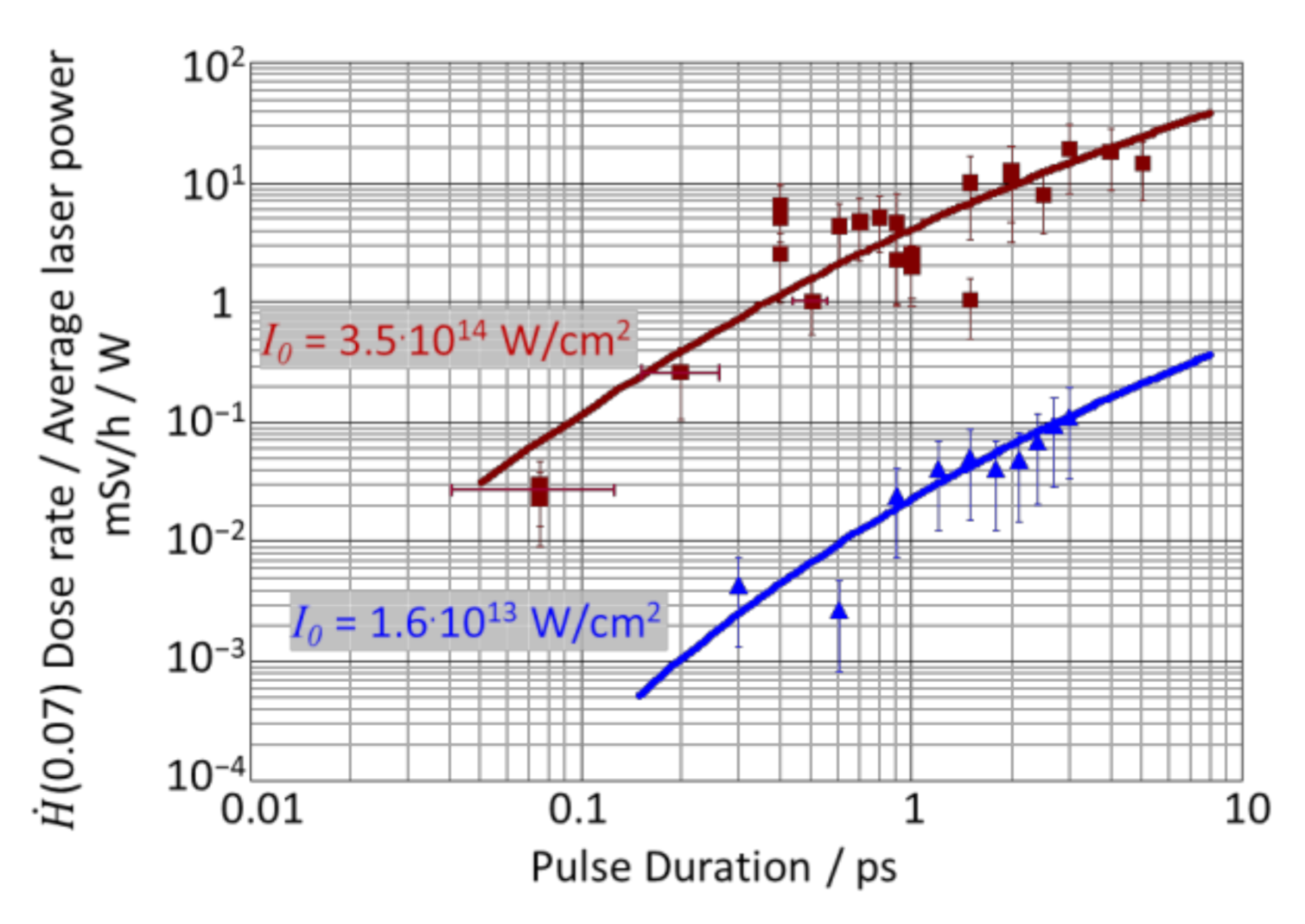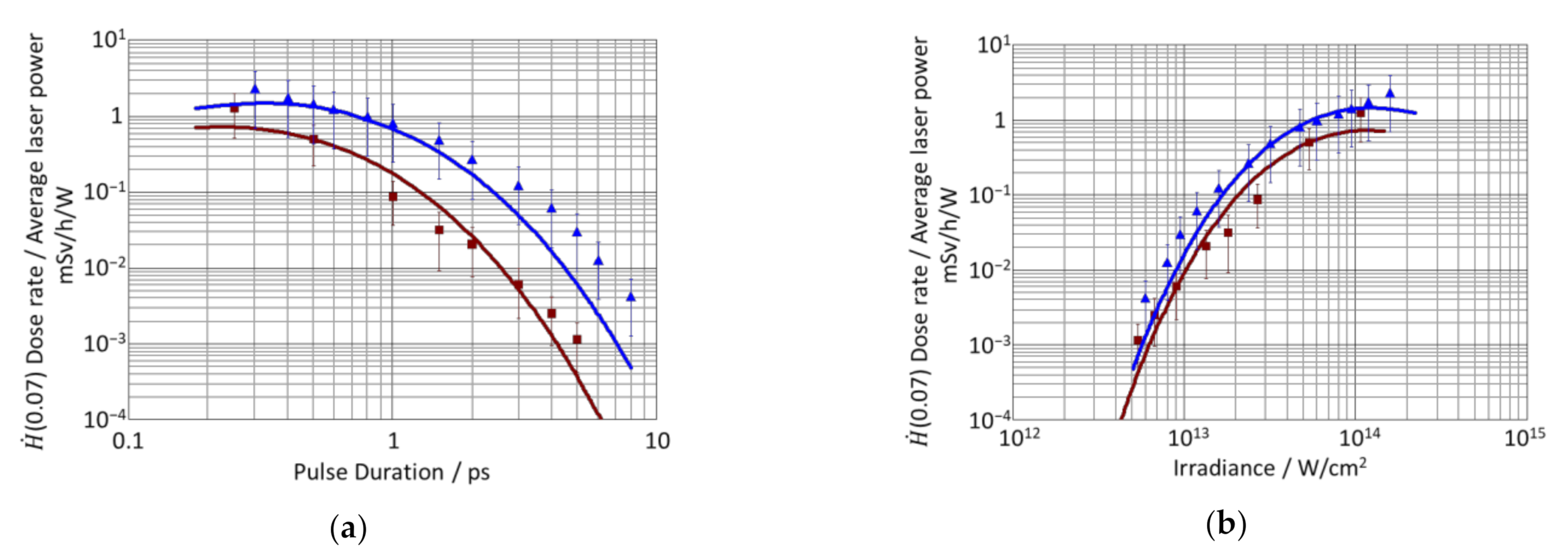Influence of Pulse Duration on X-ray Emission during Industrial Ultrafast Laser Processing
Abstract
1. Introduction
2. Influence of the Pulse Duration on the Dose Rate
2.1. Spectral Power of Emission
2.2. Number Density of Hot Electrons
2.3. Modified Fraction of Hot Electrons
2.4. Dose Rate
3. Experiments and Verification of the Model
3.1. Experimental Setup
3.2. Results
- As shown in Figure 2a, at a given pulse duration, a smaller beam diameter (blue values) results in a higher irradiance. The increase in the X-ray emission with increasing irradiance is very strong, overriding the effect of the larger plasma volume.
- In Figure 2b, at a given irradiance, a smaller beam diameter (blue values) means that a longer pulse duration was applied. Figure 1 shows the increase in the X-ray emission with a pulse duration that is quite strong. Since the increase in the X-ray emission with increasing plasma volume VP is slightly less pronounced than the increase in the X-ray emission with increasing pulse duration, the values obtained with the larger beam diameter and shorter pulses (red) are slightly lower.
4. Conclusions
Author Contributions
Funding
Institutional Review Board Statement
Informed Consent Statement
Data Availability Statement
Acknowledgments
Conflicts of Interest
References
- Weber, R.; Freitag, C.; Kononenko, T.V.; Hafner, M.; Onuseit, V.; Berger, P.; Graf, T. Short-pulse Laser Processing of CFRP. Phys. Procedia 2012, 39, 137–146. [Google Scholar] [CrossRef][Green Version]
- Nolte, S.; Momma, C.; Jacobs, H.; Tünnermann, A.; Chichkov, B.N.; Wellegehausen, B.; Welling, H. Ablation of metals by ultrashort laser pulses. J. Opt. Soc. Am. B 1997, 14, 2716. [Google Scholar] [CrossRef]
- Gamaly, E.G.; Rode, A.V. Physics of ultra-short laser interaction with matter: From phonon excitation to ultimate transformations. Prog. Quantum Electron. 2013, 37, 215–323. [Google Scholar] [CrossRef]
- Russbueldt, P.; Mans, T.; Weitenberg, J.; Hoffmann, H.D.; Poprawe, R. Compact diode-pumped 1.1 kW Yb:YAG Innoslab femtosecond amplifier. Opt. Lett. 2010, 35, 4169–4171. [Google Scholar] [CrossRef]
- Negel, J.-P.; Loescher, A.; Bauer, D.; Sutter, D.; Killi, A.; Ahmed, M.A.; Graf, T. Second Generation Thin-Disk Multipass Amplifier Delivering Picosecond Pulses with 2 kW of Average Output Power. In Proceedings of the Advanced Solid State Lasers, Boston, MA, USA, 30 October–3 November 2016; Optica Publishing Group: Washington, DC, USA, 2016. ISBN 978-1-943580-20-0. [Google Scholar]
- Müller, M.; Aleshire, C.; Klenke, A.; Haddad, E.; Légaré, F.; Tünnermann, A.; Limpert, J. 10.4 kW coherently combined ultrafast fiber laser. Opt. Lett. 2020, 45, 3083–3086. [Google Scholar] [CrossRef] [PubMed]
- Nubbemeyer, T.; Kaumanns, M.; Ueffing, M.; Gorjan, M.; Alismail, A.; Fattahi, H.; Brons, J.; Pronin, O.; Barros, H.G.; Major, Z.; et al. 1 kW, 200 mJ picosecond thin-disk laser system. Opt. Lett. 2017, 42, 1381–1384. [Google Scholar] [CrossRef]
- Weber, R.; Graf, T. The challenges of productive materials processing with ultrafast lasers. Adv. Opt. Technol. 2021, 10, 239–245. [Google Scholar] [CrossRef]
- Legall, H.; Schwanke, C.; Pentzien, S.; Dittmar, G.; Bonse, J.; Krüger, J. X-ray emission as a potential hazard during ultrashort pulse laser material processing. Appl. Phys. A 2018, 124, 407. [Google Scholar] [CrossRef]
- Barkauskas, V.; Plukis, A. Prediction of the irradiation doses from ultrashort laser-solid interactions using different temperature scalings at moderate laser intensities. J. Radiol. Prot. 2022, 42, 011501. [Google Scholar] [CrossRef]
- Legall, H.; Schwanke, C.; Bonse, J.; Krüger, J. The influence of processing parameters on X-ray emission during ultra-short pulse laser machining. Appl. Phys. A 2019, 125, 570. [Google Scholar] [CrossRef]
- Legall, H.; Schwanke, C.; Bonse, J.; Krüger, J. X-ray radiation protection aspects during ultrashort laser processing. J. Laser Appl. 2020, 32, 22004. [Google Scholar] [CrossRef]
- Metzner, D.; Olbrich, M.; Lickschat, P.; Horn, A.; Weißmantel, S. X-ray generation by laser ablation using MHz to GHz pulse bursts. J. Laser Appl. 2021, 33, 32014. [Google Scholar] [CrossRef]
- Mosel, P.; Sankar, P.; Düsing, J.F.; Dittmar, G.; Püster, T.; Jäschke, P.; Vahlbruch, J.-W.; Morgner, U.; Kovacev, M. X-ray Dose Rate and Spectral Measurements during Ultrafast Laser Machining Using a Calibrated (High-Sensitivity) Novel X-ray Detector. Materials 2021, 14, 4397. [Google Scholar] [CrossRef] [PubMed]
- Schille, J.; Kraft, S.; Pflug, T.; Scholz, C.; Clair, M.; Horn, A.; Loeschner, U. Study on X-ray Emission Using Ultrashort Pulsed Lasers in Materials Processing. Materials 2021, 14, 4537. [Google Scholar] [CrossRef]
- Stolzenberg, U.; Schmitt Rahner, M.; Pullner, B.; Legall, H.; Bonse, J.; Kluge, M.; Ortner, A.; Hoppe, B.; Krüger, J. X-ray Emission Hazards from Ultrashort Pulsed Laser Material Processing in an Industrial Setting. Materials 2021, 14, 7163. [Google Scholar] [CrossRef] [PubMed]
- Giulietti, D.; Gizzi, L.A. X-ray emission from laser-produced plasmas. Riv. Nuovo Cim. 1998, 21, 1–93. [Google Scholar] [CrossRef]
- Balmer, J.E.; Donaldson, T.P. Resonance Absorption of 1.06- μm Laser Radiation in Laser-Generated Plasma. Phys. Rev. Lett. 1977, 39, 1084–1087. [Google Scholar] [CrossRef]
- Weber, R.; Giedl-Wagner, R.; Förster, D.J.; Pauli, A.; Graf, T.; Balmer, J.E. Expected X-ray dose rates resulting from industrial ultrafast laser applications. Appl. Phys. A 2019, 125, 635. [Google Scholar] [CrossRef]
- Behrens, R.; Pullner, B.; Reginatto, M. X-ray emission from materials processing lasers. Radiat. Prot. Dosimetry 2019, 183, 361–374. [Google Scholar] [CrossRef]
- Cui, Y.-Q.; Wang, W.-M.; Sheng, Z.-M.; Li, Y.-T.; Zhang, J. Laser absorption and hot electron temperature scalings in laser–plasma interactions. Plasma Phys. Control. Fusion 2013, 55, 85008. [Google Scholar] [CrossRef]
- Tan, T.H.; McCall, G.H.; Williams, A.H. Determination of laser intensity and hot-electron temperature from fastest ion velocity measurement on laser-produced plasma. Phys. Fluids 1984, 27, 296. [Google Scholar] [CrossRef]
- Weber, R.; Balmer, J.E.; Lädrach, P. Thomson parabola time-of-flight ion spectrometer. Rev. Sci. Instrum. 1986, 57, 1251–1253. [Google Scholar] [CrossRef]
- Wilks, S.C.; Kruer, W.L.; Tabak, M.; Langdon, A.B. Absorption of ultra-intense laser pulses. Phys. Rev. Lett. 1992, 69, 1383–1386. [Google Scholar] [CrossRef] [PubMed]
- Kruer, W.L. The Physics of Laser Plasma Interactions. Addison-Wesley Publishing, Co.: Reading, MA, USA, 1988. [Google Scholar]
- Mora, P.; Pellat, R. Self-similar expansion of a plasma into a vacuum. Phys. Fluids 1979, 22, 2300. [Google Scholar] [CrossRef]
- Valentin, J. Relative biological effectiveness (RBE), quality factor (Q), and radiation weighting factor (wR). Ann. ICRP 2003, 33, 1–121. [Google Scholar] [CrossRef]
- Hatanaka, K.; Ida, T.; Ono, H.; Matsushima, S.; Fukumura, H.; Juodkazis, S.; Misawa, H. Chirp effect in hard X-ray generation from liquid target when irradiated by femtosecond pulses. Opt. Express 2008, 16, 12650–12657. [Google Scholar] [CrossRef] [PubMed]
- Wendrock, C. Available online: https://www.step-sensor.de/navigation-deutsch/strahlenmess-technik/ortsdosimeter/ (accessed on 3 March 2022).
- Liu, J.M. Simple technique for measurements of pulsed Gaussian-beam spot sizes. Opt. Lett. 1982, 7, 196–198. [Google Scholar] [CrossRef] [PubMed]
- Weber, R.; Balmer, J.E. Soft X-ray emission from double-pulse laser-produced plasma. J. Appl. Phys. 1989, 65, 1880–1884. [Google Scholar] [CrossRef]


Publisher’s Note: MDPI stays neutral with regard to jurisdictional claims in published maps and institutional affiliations. |
© 2022 by the authors. Licensee MDPI, Basel, Switzerland. This article is an open access article distributed under the terms and conditions of the Creative Commons Attribution (CC BY) license (https://creativecommons.org/licenses/by/4.0/).
Share and Cite
Holland, J.; Weber, R.; Sailer, M.; Graf, T. Influence of Pulse Duration on X-ray Emission during Industrial Ultrafast Laser Processing. Materials 2022, 15, 2257. https://doi.org/10.3390/ma15062257
Holland J, Weber R, Sailer M, Graf T. Influence of Pulse Duration on X-ray Emission during Industrial Ultrafast Laser Processing. Materials. 2022; 15(6):2257. https://doi.org/10.3390/ma15062257
Chicago/Turabian StyleHolland, Julian, Rudolf Weber, Marc Sailer, and Thomas Graf. 2022. "Influence of Pulse Duration on X-ray Emission during Industrial Ultrafast Laser Processing" Materials 15, no. 6: 2257. https://doi.org/10.3390/ma15062257
APA StyleHolland, J., Weber, R., Sailer, M., & Graf, T. (2022). Influence of Pulse Duration on X-ray Emission during Industrial Ultrafast Laser Processing. Materials, 15(6), 2257. https://doi.org/10.3390/ma15062257





